The fragments of architecture and the peace of instability
The slivers of architecture
"the timeless task of architecture is to create embodied existential metaphors that concretize and structure man's being in the world. images of architecture reflect and externalize ideas and images of 1ife; architecture materializes our images of ideal life. buildings and towns enable us to structure, understand, and remember the shapeless flow of reality and, ultimately, to recognize and remember who we are. architecture enables us to place ourselves in the continuum of culture".
Juhani Pallasmaa: "Architecture of the Seven Senses." A+U, July 1994
The built environment, our spaces are vehicles and transformers of our identity, charged with personal and emotional decisions; they give home to our communities and our emotions. With thousands of aesthetic decisions, we slowly shape our cities, which thus become the treasury of our memories. Although this is an old story, the process is becoming increasingly fragmented, and will be transformed into a network. This is partly due to the development of technological media: the spread of customisable spaces has considerably altered our notions of personal or communal space. Is it not a strange feeling when a friend sneaks a peek into our "My Documents" folder, and do we not make stereotypical assessments of people on the basis of how the icons are arranged on their Desktops? But let us go even further. What has changed is not only the idea of space, but thanks to the adaptability of media spaces, also how space is designed. We receive the graphic user interface of an operating system as an end product, but then we customise it. I know that the concept of an architecture that is shaped by its users is half a century old, and I am aware of the many failed experiments.
Architecture transforms in a social process, relies on a host of consensuses, and it is not a single-author medium, if architects often insist on the contrary. This is why it is worth keeping an eye on those changes that occur in media with a lower inertia (ones that take less energy to change), like writing. With the appearance of Wikipedia and the blogosphere, community decisions and authority based on personal, rather than institutional trust are constantly growing in importance. Now that we are already entrusting our knowledge to joint decisions, it may be fair to assume that we will be less and less inclined to accept the authority of the designing professions.
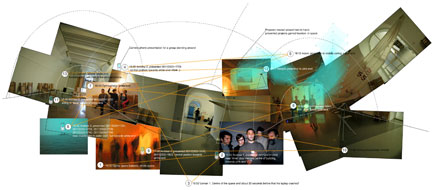
Open Source Architecture Performance, 2003 RAM4, Helsinki (Haque, Jacobs, Paterson, SomlaiFischer, Wolf). For two hours, with the participation of a fifty-strong audience, the five performers transformed an underground space into a room of memories and opinions, using rules of movement, stickers and portable projectors.
We may not be able to build crystal palaces without drafted designs. But then, we may prefer to paste together the fragments ourselves, and instead of trying to conform to an order, we can build it from its elements; and this order may be more interesting, which is what I want to discuss in the next chapter.
The garden of complexity
"The great secret of life is finding the margin between flexibility and rigidity, the state between the closely coordinated and the unstructured."
Beáta Oborny: " Véletlen és szabály, avagy hogyan játsszunk egy hangyabollyal?" ( Chance or rule, or, how to play with an anthill?). Beszélő, 2006
I do not want to use science merely as a metaphor, so allow me to briefly introduce the theory of complexity, which has gained recognition in many fields and levels. Emergence, one of the key concepts, describes the observation in several natural sciences , viz. that systems, i.e., the sum of interrelated elements, show more complex behaviours than the elements individually. A complex system must be examined both from the bottom up, and on the higher levels.
Here is a diagram that first appeared in a 1976 publication of biologist Robert May, and has become a popular illustration of complexity.
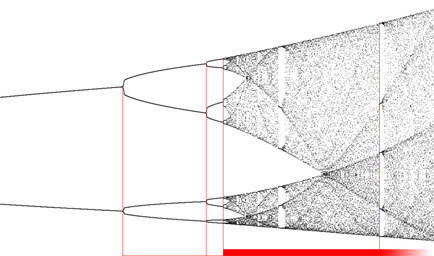
Complexity: beyond order, before chaos; bifurcation diagram (drawn by the author).
In the representation of the simple function [ xn+1 = a xn(1 - xn) ], there is a stable state on the left side, chaos and disorder on the right. But there are transitions between the two, patterns, a structure that cannot be read out directly from the basic function, nor can the function be found in the pattern. This is the threshold that complexity theory deals with; the rules are known but the results are not obvious, and the systems are examined in their relations.
There are numerous emergent phenomena in nature: to quote only two simple ones, a swarm of bees flies faster than any one bee; anthills have their own age, transform throughout the decades, react differently to their environment, independently of the age of the ants inside.
This concept, even if we only register the phenomenon without understanding its workings, offers important alternative ways of thinking in almost all areas. Think again of identity, fast fragmenting. Stability does not reside in the unshakable; cultural values are not tied to simple rules.
But if we return to the world of symbols, we may draw a parallel between the respective levels of perception of complexity and chaos, and of the garden and the wilderness. Though this correspondence greatly simplifies the concepts in question, the symbol of the garden may help us towards an understanding of fragmentarily structured architecture. I can never keep the garden completely under my control, nor is it alien to me: it is somewhere between the two, because I am aware of its structure, but at the same time, it is constantly changing. A system in a state of rest is a dead system. Living systems are never still. This is why we love gardens.
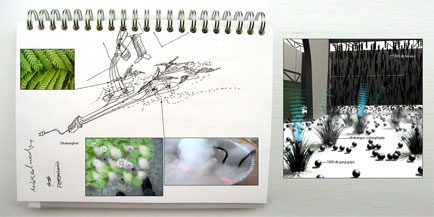
Ultrasound Garden - Dry steam, ultrasound, ferns, water
The metamorphosis of objects and spaces
The massive presence of electronic devices, made chiefly in the Far East, and particularly in China, may pose a very interesting alternative: the vision of ubiquitous computing did not grow out of the elite research laboratories of developed countries, but of cheap lighters playing silly songs. The millions of infrared links, IC's, sensors, communicating objects will start to build this global network of technological reality. And then the ubiquitous will include the spaces of pantries, garages, handbags, living and bedrooms, the world of the technological media will open for the domestic, showing the way to a new kind of literacy. The migration of these objects, and the associated cultural narratives will create considerable changes in our culture of spaces and objects.

Chirping tree - anti-sleep beeper, toy car motor, wire
The peace of instability
During the design of the installation, we try to make spaces that work with the above discussed relations and atmosphere in the medium of built reality, the space between people. In an attempt to (re)produce our culture of spaces and objects as transformed by Asian migration, we make cheap technological materials, ultrasound gardens and interactive bricks, which may present an interesting model for everyone, one of a contemporary migrant architecture, which exchanges the ideals of stability and the representation of the nation state for a far more flexible design that gives the chance to a million parallel and personal cultures of space. Complex, continuously changing space, which nevertheless shows patterns and relations, may be the alternative to the formal experiments of contemporary architecture.
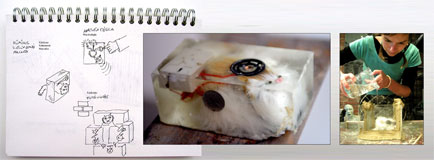
Cat brick - interactive toy cat, connections, synthetic resin
Architecture - pieces and prototypes, instead of models
The project is developed not through the search for concepts and the graphical representation of the visions, but chiefly through the building of prototype spaces. What we are looking for is partly created by the transformed concepts of space, so that is exactly where we should search for the value. The perception of the spaces to be expected can be completely different from that of the usual, static spaces, so it is difficult to design and perceive them through representations, models or drawings. All the same, we need to emphasise that what motivates us is not the novelty of the products and materials, but architecture, the system that grows out of these, and we want to construct a real piece of it from the results of our experiments.
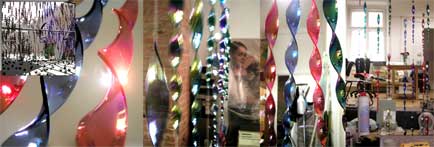
Falling wall - spirals whirling in the wind
Pavilion menu
The pavilion is a place of transformation, of pasted cultures, a device in the media space with which we want to verify our thoughts. Though this two-month exhibition does not allow us to do so, it would be important to present this architectural experiment together with the code of creation, so that it remain freely alterable.
• Take a toy and learn to recycle it
• Get to know the context and the culture
• Negotiate the space, connect a new object, change what has already been there
• Take a few along and distribute them.
|